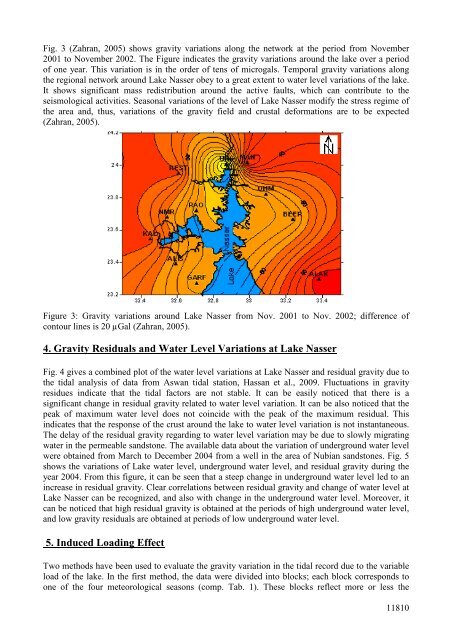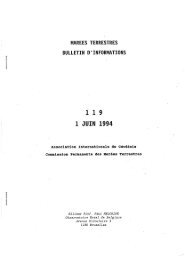marees terrestres bulletin d'informations - Université de la Polynésie ...
marees terrestres bulletin d'informations - Université de la Polynésie ...
marees terrestres bulletin d'informations - Université de la Polynésie ...
You also want an ePaper? Increase the reach of your titles
YUMPU automatically turns print PDFs into web optimized ePapers that Google loves.
Fig. 3 (Zahran, 2005) shows gravity variations along the network at the period from November<br />
2001 to November 2002. The Figure indicates the gravity variations around the <strong>la</strong>ke over a period<br />
of one year. This variation is in the or<strong>de</strong>r of tens of microgals. Temporal gravity variations along<br />
the regional network around Lake Nasser obey to a great extent to water level variations of the <strong>la</strong>ke.<br />
It shows significant mass redistribution around the active faults, which can contribute to the<br />
seismological activities. Seasonal variations of the level of Lake Nasser modify the stress regime of<br />
the area and, thus, variations of the gravity field and crustal <strong>de</strong>formations are to be expected<br />
(Zahran, 2005).<br />
Figure 3: Gravity variations around Lake Nasser from Nov. 2001 to Nov. 2002; difference of<br />
contour lines is 20 µGal (Zahran, 2005).<br />
4. Gravity Residuals and Water Level Variations at Lake Nasser<br />
Fig. 4 gives a combined plot of the water level variations at Lake Nasser and residual gravity due to<br />
the tidal analysis of data from Aswan tidal station, Hassan et al., 2009. Fluctuations in gravity<br />
residues indicate that the tidal factors are not stable. It can be easily noticed that there is a<br />
significant change in residual gravity re<strong>la</strong>ted to water level variation. It can be also noticed that the<br />
peak of maximum water level does not coinci<strong>de</strong> with the peak of the maximum residual. This<br />
indicates that the response of the crust around the <strong>la</strong>ke to water level variation is not instantaneous.<br />
The <strong>de</strong><strong>la</strong>y of the residual gravity regarding to water level variation may be due to slowly migrating<br />
water in the permeable sandstone. The avai<strong>la</strong>ble data about the variation of un<strong>de</strong>rground water level<br />
were obtained from March to December 2004 from a well in the area of Nubian sandstones. Fig. 5<br />
shows the variations of Lake water level, un<strong>de</strong>rground water level, and residual gravity during the<br />
year 2004. From this figure, it can be seen that a steep change in un<strong>de</strong>rground water level led to an<br />
increase in residual gravity. Clear corre<strong>la</strong>tions between residual gravity and change of water level at<br />
Lake Nasser can be recognized, and also with change in the un<strong>de</strong>rground water level. Moreover, it<br />
can be noticed that high residual gravity is obtained at the periods of high un<strong>de</strong>rground water level,<br />
and low gravity residuals are obtained at periods of low un<strong>de</strong>rground water level.<br />
5. Induced Loading Effect<br />
Two methods have been used to evaluate the gravity variation in the tidal record due to the variable<br />
load of the <strong>la</strong>ke. In the first method, the data were divi<strong>de</strong>d into blocks; each block corresponds to<br />
one of the four meteorological seasons (comp. Tab. 1). These blocks reflect more or less the<br />
11810



